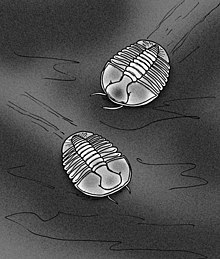| Typhlokorynetes Temporal range: | |
|---|---|
 | |
| T. plana | |
| Scientific classification | |
| Kingdom: | |
| Phylum: | |
| Class: | |
| Order: | |
| Suborder: | Trinucleina |
| Family: | |
| Subfamily: | Endymioniinae |
| Genus: | Typhlokorynetes Shaw, 1966[1] |
| Binomial name | |
| Typhlokorynetes plana (Raymond, 1937) | |
| Synonyms | |
| |
Typhlokorynetes plana is a species of small, button-shaped asaphid trilobites of the family Raphiophoridae that lived during the Early Tremadocian of Vermont, United States.
Etymology
The generic epithet is a compound word of the Greek words "Typhlos," meaning "blind," and "Korynetes," which means "club-bearer," in reference to the animal's eyeless state, and the glabellum that is shaped in the outline of a club or bowling pin.[1] The specific name "plana" refers to the flattened nature of the body.
History of taxonomy
The first fossils of this trilobite were described by P. E. Raymond in 1937 as a blind proetid that he named "Warburgella" plana.[2] In 1959, "W." plana would be redescribed by H. B. Whittington as a species of Raymondaspis in the family Styginidae.[3] Alan Shaw voiced a similar opinion when he moved it into its own genus and family, Typhlokorynetes in Typhlokorynetidae, in that it maybe a specialized styginid with unusual or aberrant sutures and hypostome anatomy.[1] During the 1970s, it was then reappraised as a relative of Endymion in Raphiophoridae.
Occurrence
Specimens are known from the Highgate Formation in northwestern Vermont.
References
- 1 2 3 Shaw, Alan B. "Paleontology of Northwestern Vermont. XII. Fossils from the Ordovician Highgate Formation." Journal of Paleontology (1966): 1312-1330.
- ↑ RAYMOND, P.E., 1937, Upper Cambrian and Lower Ordovician Trilobita and Ostracoda from Vermont: Geol. Soc. America, Bull., v. 48, p. 1079-1146, 4 pls
- ↑ WHITTINGTON, H. B., 1959a, Family Styginidae, in Treatise on invertebrate paleontology, pt. 0, Arthropoda 1: Lawrence, Kansas, Geol. Soc. America and Kansas Univ. Press, p. 365-367, Figs. 275-277